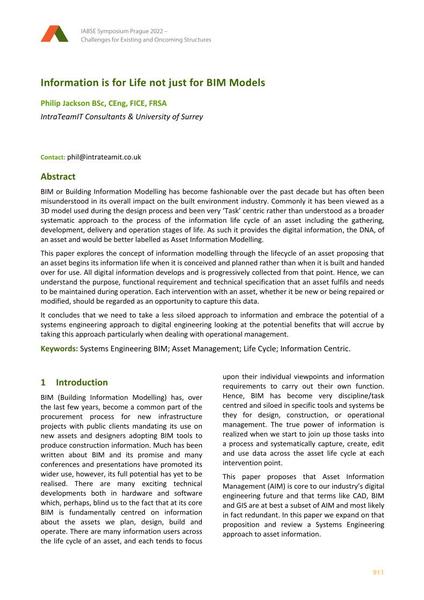Information is for Life not just for BIM Models

|
|
|||||||||||
Détails bibliographiques
| Auteur(s): |
Philip Jackson
(IntraTeamIT Consultants & University of Surrey)
|
||||
|---|---|---|---|---|---|
| Médium: | papier de conférence | ||||
| Langue(s): | anglais | ||||
| Conférence: | IABSE Symposium: Challenges for Existing and Oncoming Structures, Prague, Czech Republic, 25-27 May 2022 | ||||
| Publié dans: | IABSE Symposium Prague 2022 | ||||
|
|||||
| Page(s): | 911-919 | ||||
| Nombre total de pages (du PDF): | 9 | ||||
| DOI: | 10.2749/prague.2022.0911 | ||||
| Abstrait: |
BIM or Building Information Modelling has become fashionable over the past decade but has often been misunderstood in its overall impact on the built environment industry. Commonly it has been viewed as a 3D model used during the design process and been very ‘Task’ centric rather than understood as a broader systematic approach to the process of the information life cycle of an asset including the gathering, development, delivery and operation stages of life. As such it provides the digital information, the DNA, of an asset and would be better labelled as Asset Information Modelling. This paper explores the concept of information modelling through the lifecycle of an asset proposing that an asset begins its information life when it is conceived and planned rather than when it is built and handed over for use. All digital information develops and is progressively collected from that point. Hence, we can understand the purpose, functional requirement and technical specification that an asset fulfils and needs to be maintained during operation. Each intervention with an asset, whether it be new or being repaired or modified, should be regarded as an opportunity to capture this data. It concludes that we need to take a less siloed approach to information and embrace the potential of a systems engineering approach to digital engineering looking at the potential benefits that will accrue by taking this approach particularly when dealing with operational management. |
||||
| Mots-clé: |
cycle de vie
|
||||
| Copyright: | © 2022 International Association for Bridge and Structural Engineering (IABSE) | ||||
| License: | Cette oeuvre ne peut être utilisée sans la permission de l'auteur ou détenteur des droits. |
||||
